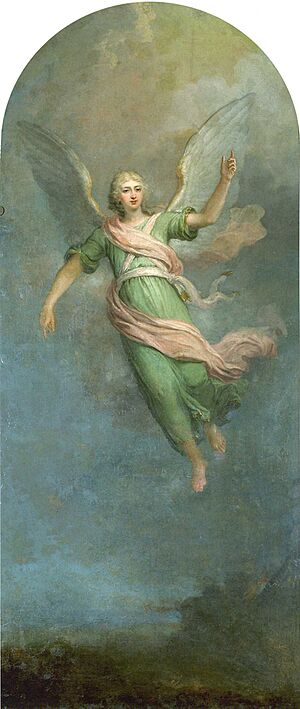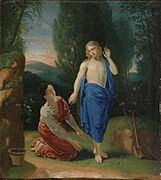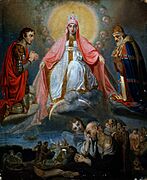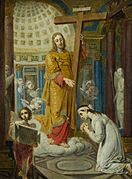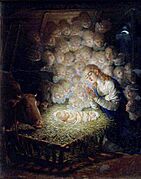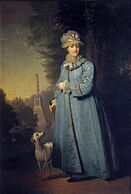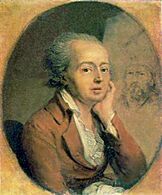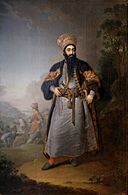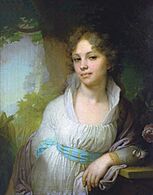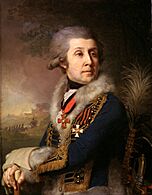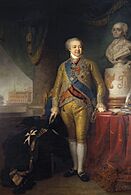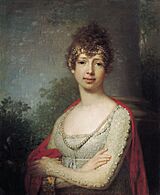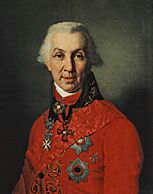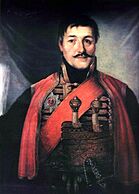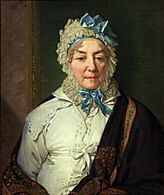Vladimir Borovikovsky facts for kids
Quick facts for kids
Vladimir Borovikovsky
|
|
|---|---|
| Владимир Боровиковский | |
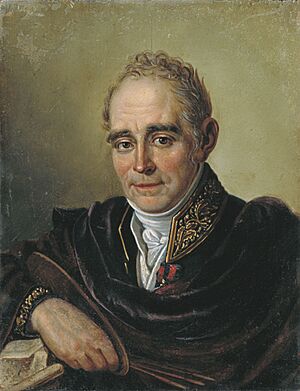
Portrait by Ivan Bugaevsky-Blagodatny (1824)
|
|
| Born |
Vladimir Lukich Borovikovsky
August 4 [O.S. July 24] 1757 Mirgorod, Cossack Hetmanate, Russian Empire
|
| Died | April 18 [O.S. April 6] 1825 (aged 67) St. Petersburg, Russian Empire
|
| Education | Member Academy of Arts (1795) |
| Alma mater | Imperial Academy of Arts |
| Known for | Painting |
| Movement | Orientalist |
Vladimir Lukich Borovikovsky (born July 24, 1757 – died April 6, 1825) was a famous Russian artist. He came from a Ukrainian Cossack family. He worked for Empress Catherine the Great and was one of the most important portrait painters in Russia around the year 1800.
Contents
The Life of Vladimir Borovikovsky
Vladimir Borovikovsky was born in Mirgorod, a town in what was then the Cossack Hetmanate (now Ukraine). His birthday was July 24, 1757. His father, Luka Borovik, was an icon painter.
Early Life and Art
Vladimir's family had a tradition of serving as Cossacks. All four of his father's sons were Cossacks in the Mirgorod regiment. But Vladimir decided to leave early. He became a "poruchik," which is a military rank, and then focused on art. He mostly painted icons for local churches.
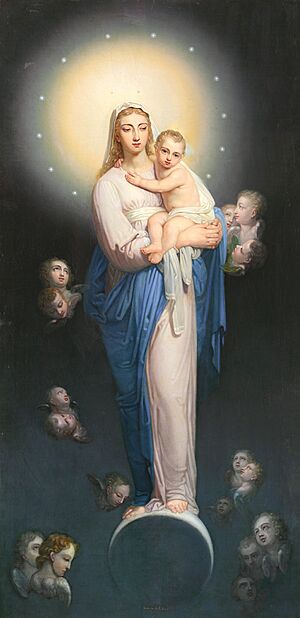
Borovikovsky lived in Mirgorod until 1788. During this time, he painted icons and portraits. His style was influenced by the Cossack Baroque art tradition.
Moving to Saint Petersburg
A friend named Vasily Kapnist was preparing a place for Empress Catherine II to stay. This was in Kremenchuk, as she traveled to the newly taken land of Crimea. Kapnist asked Borovikovsky to paint two special pictures for the Empress's rooms.
One painting showed Peter I of Russia and Catherine II as farmers planting seeds. The other showed Catherine II as Minerva, a Roman goddess. The Empress loved these paintings very much. She asked the artist to move to Saint Petersburg.
After September 1788, Borovikovsky lived in Saint Petersburg. He changed his last name from Borovik to Borovikovsky. This new name sounded more noble. For his first ten years in the city, he lived with Prince Nikolay Lvov. Lvov was a poet, architect, musician, and art expert. His ideas greatly influenced Borovikovsky's art.
Vladimir was 30 years old, too old to join the St. Petersburg Imperial Academy of Arts. So, he took private lessons. His teachers were Dmitry Levitzky and later Johann Baptist von Lampi the Elder from Austria.
Becoming a Famous Portrait Painter
In 1795, Borovikovsky was made an "academician." This meant he was a recognized master artist. He became a very popular portrait painter. He painted about 500 portraits during his life. About 400 of these still exist today.
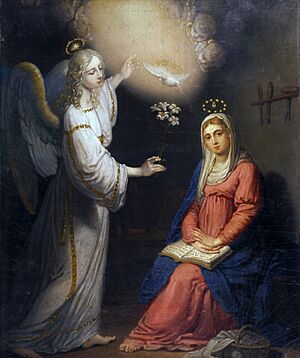
He had his own art studio. Sometimes, he had assistants help him paint the less important parts of a portrait. He painted many important people. These included members of the royal family, court officials, generals, and many rich people. He also painted famous Russian artists and writers. Most of his portraits show people in a personal, close-up way.
Some of his most famous portraits include:
- Catherine II, Empress of Russia (1794)
- Portrait of M. I. Lopukhina (1797)
- Portrait of Paul I, Emperor of Russia (1800)
- Portrait of Prince A. B. Kurakin (1801–1802)
Borovikovsky did not teach at the Imperial Academy of Art. But students lived in his home and learned from him. Two of these students were Alexey Venetsianov and Bugaevsky-Blagodarny. Bugaevsky-Blagodarny painted the only known portrait of Vladimir Borovikovsky.
Later Life and Religious Art
After 1819, Borovikovsky joined a group called the Freemasons. He was a member of a "lodge" called Dying Sphinx. Around this time, he mostly painted icons. He created the Iconostasis (a wall of icons) for the Smolensky Cemetery church. He also painted some icons for the Kazan Cathedral in Saint Petersburg.
On April 6, 1825, he suddenly died from a heart attack. He was buried in the Lazarevskoe Cemetery in Saint Petersburg.
What Makes Borovikovsky's Art Special?
In the late 1790s, Borovikovsky became very famous for his portraits. He was known for painting with his left hand.
Portrait Styles
Most of his work focused on "chamber portraits." These are smaller, more personal portraits. In his paintings of women, he showed the ideal of beauty for his time.
The artist was very good at showing the inner feelings of the people he painted. Even in quiet, sentimental portraits, he could show many different emotions. For his painting "Catherine II for a walk in the Tsarskoselsky park" (1794), he was made an academician.
In the 1810s, Borovikovsky started painting people with strong, energetic personalities. He focused on showing their good character, nobility, and dignity. His models looked more serious. He often replaced outdoor backgrounds with indoor settings.
Borovikovsky also painted some "ceremonial portraits." These are large, formal paintings. In these, you can see how well he painted different textures. He could make velvet look soft, gold and satin look shiny, and jewels sparkle.
His art combines two styles: classicism and sentimentalism. Classicism uses clear lines and balanced compositions. Sentimentalism focuses on emotions and feelings.
In his last years, Borovikovsky returned to painting religious art. He created several icons for the Kazan Cathedral, which was being built. He also painted the iconostasis for the Church of Smolensk cemetery. He even gave painting lessons to a young artist named Alexey Venetsianov.
Religious Paintings by Borovikovsky
-
The Appearance of Christ to Mary Magdalene
-
Christmas, depicting the nativity
Portraits by Borovikovsky
-
Catherine II in Tsarskoe Selo (1794)
-
Portrait of Paul I, Emperor of Russia (1800)
-
Portrait of Gavrila Romanovich Derzhavin (1811)
-
Portrait of Ioannis Varvakis
See also
- List of Russian artists


